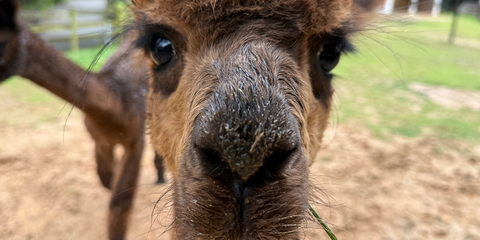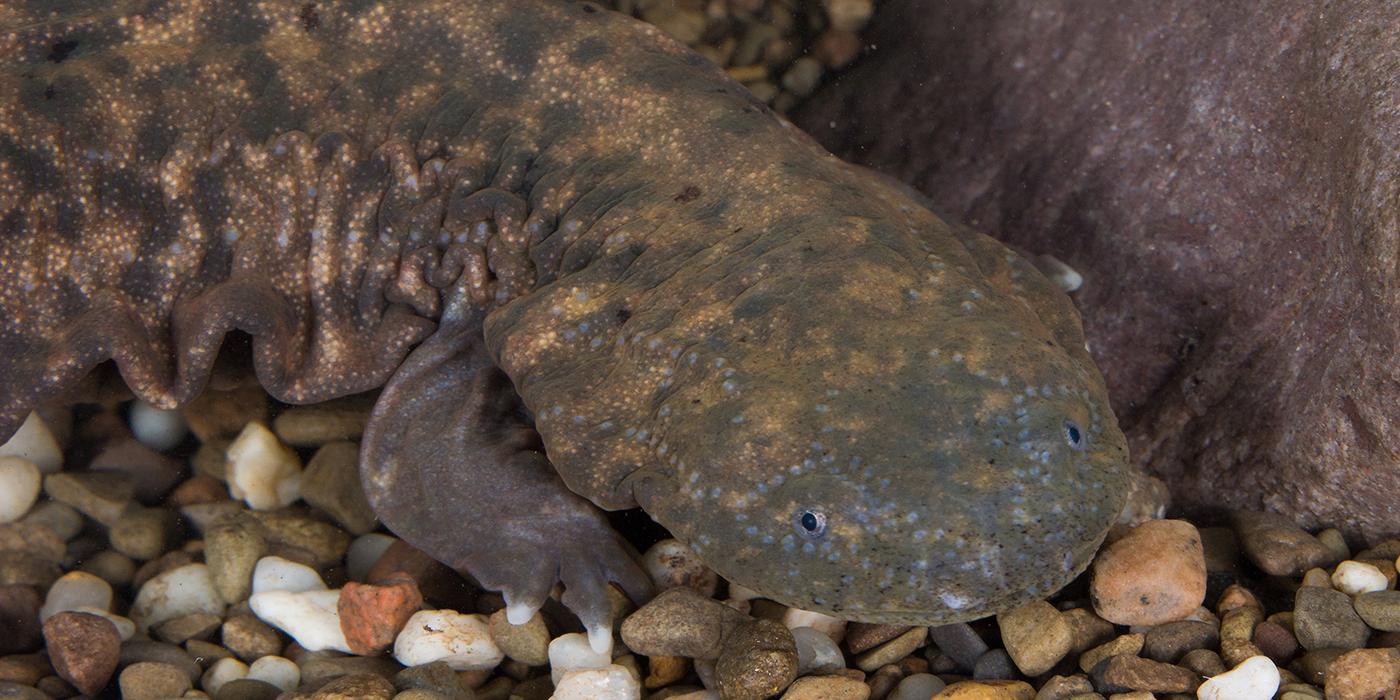Physical Description
With their flattened head and body, four short, stout legs, long rudder-like tail and very small beady eyes, they are well adapted to their swift, flowing stream habitats. Hellbenders retain a few juvenile traits as adults, such as an absence of eyelids and open gill slits.
Males and females are quite similar, but males tend to be heavier and broader. They vary in color from grayish to olive brown and occasionally, entirely black. Individuals usually sport dark mottling over the back and upper sides.
Size
Sexually mature adult hellbenders range in size from 12 to 29 inches (30 to 74 centimeters) and can weigh up to 5 pounds (2.2 kilograms).
Native Habitat
The eastern hellbender's North American range extends from southwestern and south-central New York, west to southern Illinois, and south to extreme northeastern Mississippi and the northern parts of Alabama and Georgia. A separate population occurs in east-central Missouri. A subspecies, the Ozark hellbender (Cryptobranchus a. bishopii), exists as an isolated population in southeastern Missouri and adjacent Arkansas. In New York, the hellbender is found solely in the Susquehanna and Allegheny River drainages, including their associated tributaries.
Hellbenders require swift running, well-oxygenated, unpolluted streams and rivers. An important physical characteristic of these habitats is the presence of riffle areas and abundant large flat rocks, logs or boards which are used for cover and nesting sites.
Lifespan
The life span of a hellbender in wild is thought to be up to 25 years; they can live considerably longer in human care.
Food/Eating Habits
Hellbenders mainly eat crayfish but they will also take other invertebrates and fish when available. They are "sit-and-wait" (ambush) predators and conceal themselves beneath rocks on the streambed with only their head protruding to seize crayfish and other small aquatic prey that swim by.
At the Smithsonian's National Zoo, hellbenders are fed a diet of crayfish, shrimp, smelt and earthworms.
Sleep Habits
They are nocturnal animals, seeking cover by day under large rocks and logs and becoming active at night to hunt.
Social Structure
Hellbenders are solitary creatures except for during the breeding season when they have been known to congregate, sometimes during the day, in groups of ten or more individuals.
They will defend their shelter rocks from other hellbenders, but are generally only aggressive toward each other during the breeding season, when nest defense increases in importance.
Reproduction and Development
Males excavate a large nest chamber beneath a rock in preparation for breeding. Pregnant females are either attracted to or corralled into the nest sites by the males.
Egg laying typically happens in the late summer or early fall, depending on the elevation. Females deposit two long strings of 200 to 400 eggs in a softball-sized, yellowish mass onto the nest bed. Males fertilize the eggs externally as the female deposits them. Males then drive out the females and stay in the nest cavity to brood and safeguard the eggs until they hatch 68 to 75 days later.
At hatching, the larvae are about one to 1.25 inches (25 to 30 millimeters) in length. It is thought that the larvae suffer high mortality during the first years of life, often falling prey to fish and other predators. Males and females become sexually mature in about 5 to 7 years.
Conservation Efforts
Assessed in 2004, the IUCN lists hellbenders are listed as near threatened. They are not covered by the Convention of International Trade of Endangered Species.
In the U.S., several states give the hellbender some level of protection. Illinois, Indiana, Ohio, and Maryland list it as endangered, Alabama lists it as threatened, and New York lists it as a species of special concern.
Hellbender populations are declining due to pollution and the damming of streams and rivers. Fishermen also pose a threat, as they kill hellbenders either inadvertently or occasionally for bait.
The Reptile Discovery Center's Appalachian Salamander Lab was established in recent years as an on-exhibit research facility. It complements the Smithsonian Conservation Biology Institute's Appalachian Salamander Research Program, which focuses on identifying the key threats facing wild populations through zoo-based science. The individual aquariums within the lab contain salamanders kept at slightly different temperatures. Because warm water holds less oxygen than cold water, hellbenders may be even more at risk to climate change then terrestrial salamanders. Scientists monitor hormones and body condition of salamanders in the lab to test the potential impact of climate change and rising stream water temperatures on Appalachian salamanders.
Help this Species
- Reduce, reuse and recycle — in that order! Cut back on single-use goods, and find creative ways to reuse products at the end of their life cycle. Choose recycling over trash when possible.
- Protect local waterways by using fewer pesticides when caring for your garden or lawn. Using fertilizers sparingly, keeping storm drains free of litter and picking up after your pet can also improve watershed health.
- Save water by switching to low-energy appliances, fixing leaks and turning off faucets when they aren't in use.
Animal News

Zoo Welcomes Alpacas ‘Rainstorm’ and ‘Coffee Cup’



